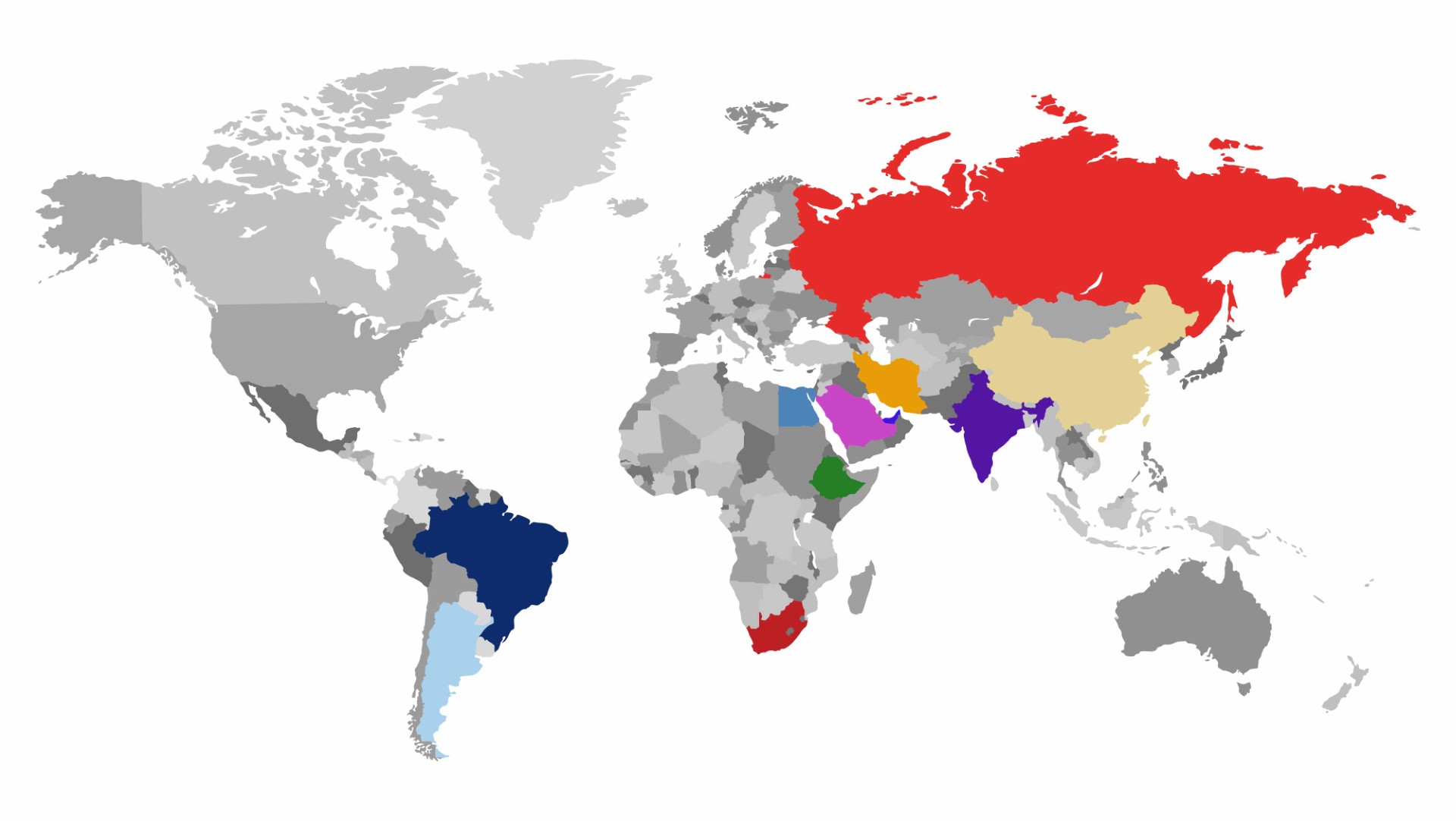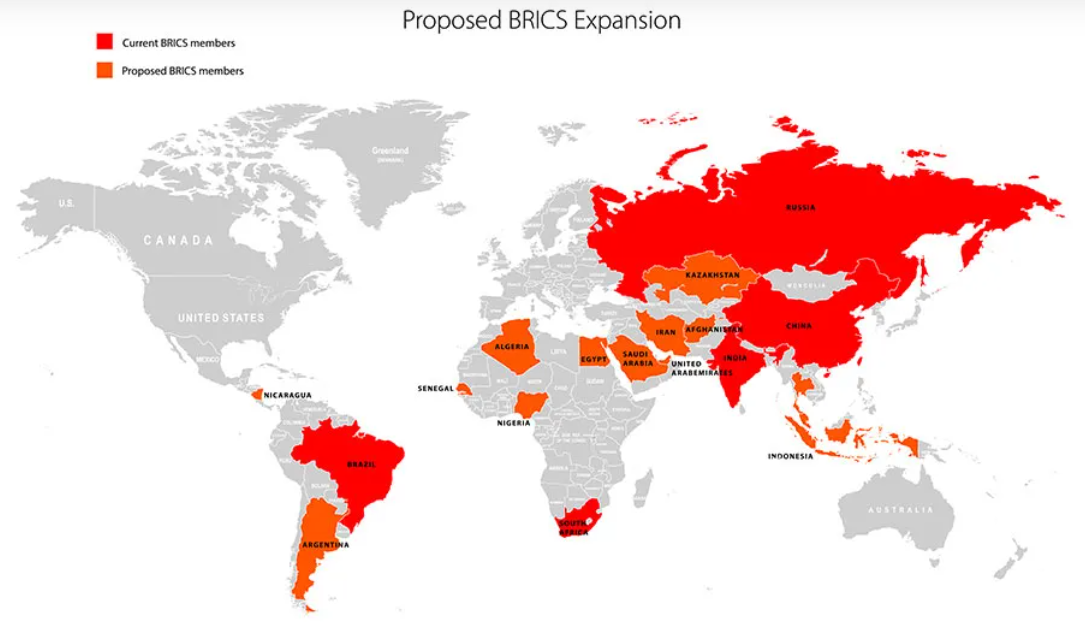The expanded BRICS – what implications does it have for aviation? Part one
When Jim O’Neill of Goldman Sachs coined the acronym the 'BRICs', meaning Brazil, Russia, India and China, over 20 years ago, identifying them as the economies that would collectively dominate the global economy by 2050, he could hardly have anticipated that South Africa would join them a decade later. But it did, even though he questioned its value to the bloc openly. But South Africa has a strategic political-economic status and its admission signified how the (now) BRICS was changing in nature. Now, and coincidentally at a meeting held in South Africa, another six countries have been invited to join, across three world regions. Together with the wider aims, a side aviation conference has laid down what the new organisation seeks to achieve in the industry and it is ambitious – mainly in its quest for open skies, something that the continent of Africa (which now has three BRICS members) was unable to achieve in almost 25 years since the Yamoussoukro Declaration. In the short term, and although the expanded BRICS organisation’s influence is being played down by western politicians, it will undoubtedly pose questions to the air transport ‘world order’ that has comfortably been in place since 1944.
Summary
- The original BRICs growth predictions have mainly come true.
- South Africa was added to the original four members over a decade ago, now six more are asked to join.
- It isn’t a done deal yet, but it could grow bigger still as many countries join the queue.
- The bloc posits itself as an alternative to the G7 – the B11.
- An aviation conference attached to the BRICS summit proposes better cooperation across passenger connectivity; creating a cargo strategy; infrastructure development; and sustainability.
The original BRICs predictions have mainly come true
When Jim O’Neill at Goldman Sachs first coined the term ‘BRICs’ in 2001 in a corporate paper he was referring by way of his acronym to four countries – Brazil, Russia, India and China – and their economic emergence globally. He believed the fast growing economies would collectively dominate the global economy by 2050.
It is easy to understand how their significance was interpreted then by Mr O’Neill, two decades on, and across numerous metrics. China has become the world’s second largest economy, with a GDP of USD17.9 trillion in 2022.
India now has the world’s largest population and just successfully landed a spacecraft on the Moon, with a view to seeking out water to aid future colonisation. It is hardly surprising that the United States has ramped up its space programme massively in recent years, having previously kicked it into the long grass.
India has the world’s fifth largest economy, at USD3.4 trillion. But spread across its 1.4 billion people its GDP per capita is a miserly USD2,389, which is the third lowest of the Top 50 countries by GDP.
Meanwhile Brazil has the largest economy by far in Latin America, at USD1.9 trillion, which is four times that of neighbouring Argentina and well ahead of Mexico.
The outlier is Russia, because it is still a poor country in some ways outside Moscow and St Petersburg. Russia is embroiled in a costly war and attendant political uncertainty that will have ramifications for years to come.
Even so, Russia came in at number 8, with a GDP of USD2.2 trillion in 2022.
The addition of South Africa added another BRIC
There are few other ‘emerging’ countries that have come up on the rails since 2001, but the acronym BRIC was changed to BRICS after the addition of South Africa – the original four having held their first summit in 2010 and having handed the Republic an invitation to join.
Mr O’Neill commented at that event that South Africa, with a population then of fewer than 50 million people, was just too small as an economy to join the BRICs ranks (it was the world’s 38th largest economy by GDP in 2022). But it did.
Since then, what became the BRICS has grown dramatically, and in one go at its summit in South Africa in Aug-2023.
Six additional countries invited to join in Aug-2023
At the 15th BRICS Summit South African President Cyril Ramaphosa announced that Argentina, Egypt, Ethiopia, Iran, Saudi Arabia, and the United Arab Emirates had been invited to join the bloc.
Full membership will take effect on 01-Jan-2024.
The expanded BRICS – a global scope outside North America and Europe
Source: CAPA – Centre for Aviation
Applying the O’Neill population formula, three of these countries can be deemed to have ‘sufficient’ population to merit BRICS membership – Egypt, Ethiopia and Iran – whereas the other three don’t have.
Populations of new BRICS member states
|
Country |
Population 2023, millions |
|
52 |
|
|
113 |
|
|
127 |
|
|
89 |
|
|
37 |
|
|
9.5 |
Source: Worldometer
Other ‘attributes’ are more appropriate today as BRICS changes into a political organisation
Population does not matter so much, 20 years on.
Acceptance factors will have included oil production, nuclear power production capability, regional influence, economic data and individual benefits appropriate to individual countries that might be transferable to others. Sociological measures, such as human rights records, were likely ignored.
But there are divisions already.
India and Brazil are concerned about accepting more members strongly aligned with China while both have been strengthening ties with the west. There are no certainties at this point.
Assuming it does all go ahead, it will be interesting to observe what acronym it now applies to itself.
BRICSAEEISAUAE doesn’t quite have a ring to it. And perhaps they should add a ‘+’ on the end, because more will likely follow.
The organisation could grow further still
Over 40 countries expressed an interest and 22 formally applied to join the grouping following its decision in 2022 to allow new members.
Algeria, Türkiye and Afghanistan are known to be interested, along with Indonesia.
Other likely contenders for membership include Kazakhstan, Nicaragua, Nigeria, Senegal and Thailand.
Potential further BRICS expansion

Source: Silk Road Briefing from Dezan Shira & Associates
Before these additions the BRICS had a combined area of 39,746,220sqkm (15,346,100 sq miles) and an estimated total population of approximately 3.21 billion – or about 26.7% of the world's land surface and 41.5% of the global population.
They had a combined nominal GDP of USD28.06 trillion (about 26.6% of the gross world product), a total GDP (PPP) of around USD56.65 trillion (32.5% of global GDP PPP), and an estimated USD4.46 trillion in combined foreign reserves.
All five states before the expansion are members of the G20 – which was created in 1999 following the Asian Financial Crisis so that emerging markets could be represented.
An alternative to the G7
But none are in the G7, which wields greater clout and is made up of four European countries, two from North America, plus Japan. One interesting proposal at the summit was that the new BRICs should set itself up specifically to be an alternative G7.
China, in particular, sees an opportunity to develop a coalition of middle ranking powers against the G7. President Xi Jinping isn’t hiding his aspiration to counter other US-led groupings via the BRICS.
Collectively, these changes and aspirations are representative of the evolving nature of the BRICS, which were established as an equitable, democratic and multi-polar world order, originally identified for the purpose of highlighting investment opportunities, and had not been a formal intergovernmental organisation.
But since 2010, when South Africa joined, they have increasingly formed into a more cohesive geopolitical bloc; a political organisation with their governments coordinating multilateral policies. Bilateral relations among BRICS are conducted mainly on the basis of non-interference, equality, and mutual benefit.
A side aviation conference at the summit outlines potential cooperation across connectivity, infrastructure and environmental issues
So how do these developments impact on the air transport business?
Speaking at the BRICS Aviation Working Group conference, which was held on the sidelines of the summit, the Airports Company South Africa (ACSA) CEO and BRICS Aviation Working Group chair, Mpumi Mpofu, insisted that the summit "was a turning point in advancing the aviation industry's function as a driver of economic growth and regional integration, with a focus on forging cooperation among the BRICS nations".
Ms Mpofu emphasised the need for greater air connectivity between the BRICS markets and the need for aviation infrastructure development. She will be aware of the pressing need for both connectivity and infrastructure in Africa and the summit added two new African members – Ethiopia and Egypt.
Ms Mpofu also emphasised the need for increased airlift as a basis for co-operation within the BRICS markets, mainly because of the vast distances between member nations, and also highlighted the role of the African Continental Free Trade Area (AfCTA) in facilitating trade and tourism, pointing to the potential of stronger BRICS-Africa ties to boost economic growth.
She further noted the multiplier effect of tourism in fostering socio-economic development across BRICS economies, emphasising the sector’s capacity to support various economic sectors.
Ms Mpofu additionally stressed the need for developing aviation infrastructure, pointing to the example of how ACSA partnered with other countries to improve airport facilities in Brazil and India (where it was an investor [India] and where it remains one [Brazil]). In order for the BRICS enterprises to collaborate properly, she urged the development of a structure that promotes alignment among the member states.
The Working Group dedicated itself to promoting investments in airport facilities, which include modernising terminals, expanding runways, and deploying advanced technologies to enhance passenger experience and efficiency.
The Deputy Minister of Transport, Lisa Mangcu, reiterated the significance of aviation as an economic driver and a vehicle for inclusive multilateralism, calling on all BRICS countries to step up efforts to improve connectivity across the board.
Mr Mangcu highlighted that airport infrastructure needed to be modernised to support expansion, and the aviation industry's need to minimise its carbon imprint.
He urged airlines and airports to utilise renewable energy sources, sustainable aviation fuels, and cutting-edge technology, such as hydrogen, to address environmental issues.
The conference concluded with a firm commitment to encouraging co-operation, connectivity, and long term expansion in the aviation industry.
Other proposals included advancing cooperation in manufacturing aircraft and components; supporting aircraft maintenance by sharing best practices, expertise and resources; and establishing training programmes.
Targeting Open Skies
The four main takeaways from this summit that will have an impact in the air transport arena beyond the BRICS countries themselves are:
- Increasing connectivity specifically between BRICS countries, prioritising the development of air services between key city pairs – which probably means more direct flights, but which could also include enhanced hubbing activities. The working group aims to commit the airlines to do feasibility assessments and actually commit to flying, and foresees itself moving towards a multilateral open sky dispensation... “quite similar to what the EU has done";
- An air cargo and trade strategy, including dedicated freighter services;
- Mutual assistance with airport infrastructure projects, which could be construction, financing or operation, or all of them;
- The greening of the industry, in some countries that have not necessarily hitherto placed those activities at the top of the agenda.
In part two of this report CAPA - Centre for Aviation will consider the possible implications the expanded BRICS could have for aviation.


